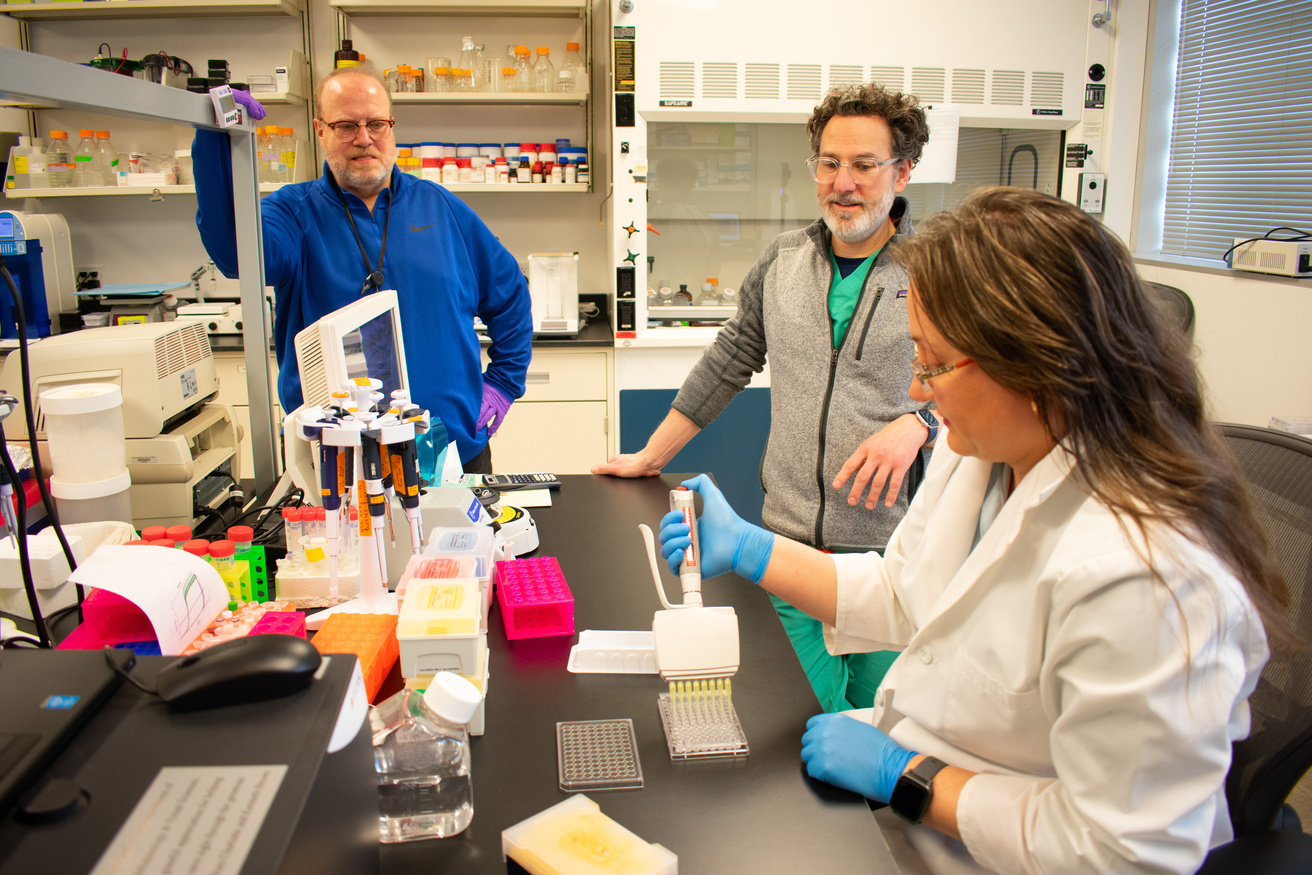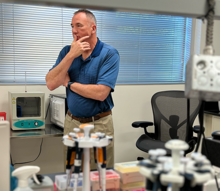
In the field of ophthalmology, few challenges are as daunting as preventing cell death in the cornea. Dr. Mark Greiner and his team at the University of Iowa are at the forefront of this battle, pioneering research that could revolutionize the treatment of corneal diseases. Their focus is on using ubiquinol, a powerful antioxidant, to prevent cell death in the cornea, potentially eliminating the need for corneal transplants in many patients.
Understanding the problem
The cornea, the clear front part of the eye, relies on a layer of cells called corneal endothelial cells to stay transparent. These cells do not regenerate, making them vulnerable to damage from various sources, including sunlight, inherited diseases, and trauma. When these cells die, the cornea becomes cloudy, leading to vision loss. Traditionally, the only solution has been corneal transplantation.
Dr. Greiner explains, “These corneal endothelial cells don’t repair themselves. They don’t divide. They can get injured easily. They never turn over, which means that they’re constantly exposed to ultraviolet rays in sunlight, various diseases, and other factors that can cause damage.”
At Iowa Lions Eye Bank, Greg Schmidt, who was the lead processing technician when Dr. Greiner first joined the faculty at Iowa in 2012, started to notice that some of the corneal tissue they were recovering and hoping to use for transplant surgeries were tearing.
Schmidt didn’t just accept these results; he wanted to know why this was happening, so he took a step back and started looking at the donor medical histories for the corneal tissues that were tearing and were unusable.
“He found a large number of those tissues that tore came from donors that had diabetes,” said Greiner. “As the Associate Medical Director at the time, I heard this and said, ‘We're gonna study this.’ And that's exactly what we did. We found that tissue from diabetic donors had a greater chance of tearing.”
Through studying the tissue of diabetic donors, the team realized that corneal endothelial cells in general were extremely sensitive to oxygen and that this played a role in the death of those cells. Greiner and his team started asking questions. “Jess Skeie along with our research scientist at the time looked at the results and said, ‘If we've got oxygen sensitive cells, shouldn’t we be looking at keeping these cells healthier by minimizing the impact of high oxygen on those cells?” Greiner said.
The role of ubiquinol
The Greiner lab’s research has uncovered that ubiquinol, the active form of Coenzyme Q10, can significantly reduce oxidative stress in corneal cells. Oxidative stress is a major factor in cell death, and by mitigating this stress, ubiquinol helps maintain the health and function of corneal endothelial cells. This discovery is particularly promising for patients with Fuchs endothelial corneal dystrophy, a common condition that affects millions worldwide and is characterized by oxidative damage.
“Ubiquinol is an antioxidant that can restore normal levels of mitochondrial function,” says Dr. Greiner. “By adding ubiquinol to the storage media for donor corneal tissue, we found that it could improve the tissue’s health. However, the challenge was its instability in liquid form.” Before they could translate this finding to patients and diseases like Fuchs dystrophy, Greiner needed to address this tricky formulation problem.
From lab to clinic
The Greiner lab team recognized that ubiquinol’s instability in liquid form posed a challenge that required thinking outside their skillset. In a move that he credits as a “total game changer,” Dr. Greiner reached out for help to Dr. Ali Salem from the College of Pharmacy and the current Associate Vice President for Research. The two researchers struck up a collaboration and friendship that took Dr. Greiner’s work to the next level. Together, the Greiner and Salem labs developed a stable, soluble form of ubiquinol that can be used in various liquid formulations, including eye drops.
This breakthrough means that instead of using the ubiquinol solution exclusively in cornea storage media and relying solely on surgical interventions to treat corneal diseases, patients could potentially use a ubiquinol solution as a topically applied eye drop to maintain the health of their corneal endothelial cells. This non-invasive approach could prevent the progression of diseases like Fuchs dystrophy, reducing the need for corneal transplant surgery all together.
Meet the team
Dr. Greiner’s research is supported by a dedicated and talented team. At the core is Dr. Jessica Skeie, the Senior Research Scientist. Dr. Skeie has been with the University of Iowa’s ophthalmology department for over 20 years. She began her journey as a bioengineering student, later switching to cell biology for her PhD. Her extensive experience and expertise are invaluable to the lab’s success.
“Jess [Skeie] is absolutely essential to our team,” says Dr. Greiner. “She has been in ophthalmology longer than anyone in my lab and brings a wealth of knowledge and experience.”

Greg Schmidt, the director of research and business development for the Iowa Lions Eye Bank, has played an outsized role in helping create the Greiner lab, as well as challenging Greiner to ask the big questions. “Greg helped found the lab and encourage me from the beginning to dream bigger than what we initially set out to achieve.” Greiner added, “Greg’s technical expertise in handling corneal tissues have been essential in establishing several techniques that have made our research possible.” As mentioned previously, it was also Schmidt who first started to notice the fragility of some cornea transplant tissue from diabetic donors that eventually set Greiner on his current course of research.
The team also includes two outstanding research assistants, Hanna Shevalye and Tim Eggleston. Hanna, who joined the lab from the VA, is known for her exceptional imaging skills, producing high-quality scientific images that are crucial for this research. Tim, a seasoned research associate with over 20 years at the University, excels in protein identification, contributing significantly to the lab’s projects.
“Hanna and Tim are my go-to people for hands-on bench work,” Dr. Greiner notes. “Their expertise and dedication are critical to our research.”
Additionally, the lab benefits from a cadre of students from the Department of Ophthalmology and Visual Sciences, the Carver College of Medicine, and the College of Pharmacy. These students, ranging from undergraduates and medical students to PhDs and postdoctoral fellows, contribute to various projects and gain invaluable experience in the process. Most of them have gone on to successful careers in ophthalmology and fields related to the research done in the Greiner lab.
The power of philanthropy
The Greiner lab’s work has been significantly supported by philanthropic donations. Early funding from grateful patients enabled the initial research that led to these breakthroughs. Philanthropy continues to play a crucial role, filling gaps where federal funding falls short and allowing the lab to pursue innovative ideas without administrative hindrances.
“Philanthropy is why I’m here talking to you about this wonderful project,” says Dr. Greiner. “It opened the door and let us go to town with our work. It continues to sustain our efforts and is vital for our research.”
Philanthropic support has been particularly essential for funding the personnel who make up Dr. Greiner’s team. “Two-thirds of my budget is for our personnel, and not for my time or for the experiments,” Dr. Greiner explains. “It is the people in my lab who really need the support. Philanthropy helps us pay for these world-class researchers who are essential to our success.”
Looking ahead
The journey from discovery to clinical application is long and requires substantial resources. Continued support from donors is essential to advance this promising and impactful research. One of the reasons private donors have funded this research in the Greiner lab in the past is because of the huge potential of this research to treat virtually any eye disease where cells are dying because of the effects of oxidative damage. By investing in Dr. Greiner’s work, these philanthropists feel like they can help bring new treatments to patients and prevent vision loss for millions across the globe.
Dr. Greiner emphasizes, “There is no source of funding that is too small or too big to make this research go forward. Philanthropy helps us in so many ways, from jump-starting new ideas to filling the gaps where federal funds fall short.”
Dr. Mark Greiner’s research on ubiquinol represents a beacon of hope for those suffering from corneal diseases. With the continued support of philanthropy, his team can push the boundaries of medical science and improve the quality of life for countless individuals. This groundbreaking work not only highlights the potential of ubiquinol in preventing cell death in the cornea but also underscores the critical role that philanthropy plays in advancing medical research.
This article originally appeared on the website for the Department of Ophthalmology and Visual Sciences at University of Iowa Health Care.
